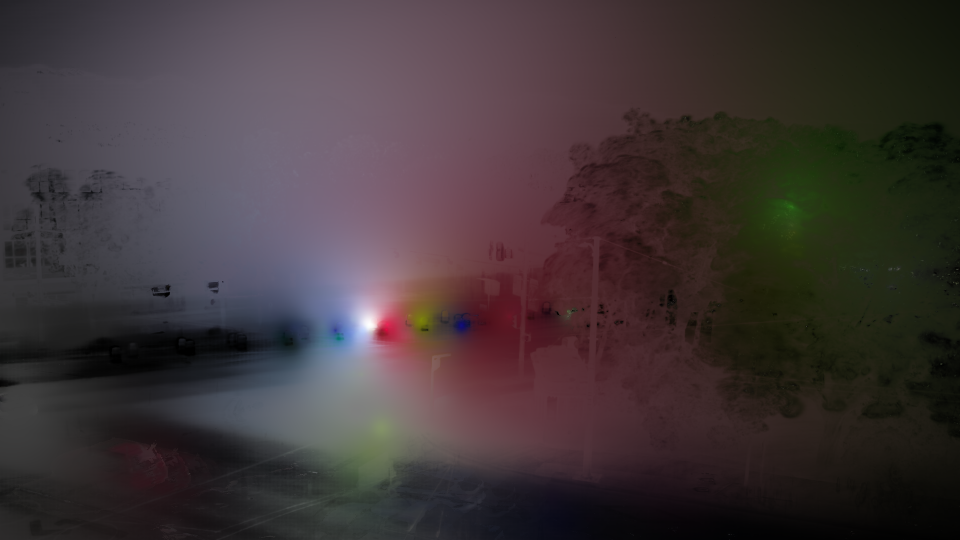Ben Bogart’s new work, A diffraction of past/stability and present/dynamism, will be featured on the Mount Pleasant Community Art Screen from December 17th—26th, 2021. This beautifully complex work will screen for 7.5 hours/day, you can read more about the project here. We will also be presenting Ben’s work in our gallery, with an artist talk in January, 2022. We’re excited to share this work with you, and wanted to introduce you to Ben’s practice — read on for a mini interview with Ben Bogart!
Please tell us a bit about yourself and your creative practice!
I’m a non-binary agender adisciplinary conceptual artist and as I write this I’m constantly distracted by hummingbirds coming to visit my new feeder and delighted watching their tongues as they flick them out of their beaks after each sip of nectar. For over two decades I’ve focused on computational processes as artistic material; I think of the use of computational processes as following from the instruction works of 1960s conceptual art onward. In my artistic practice I’ve engaged with methods including physical modelling, chaotic equations, feedback systems, evolutionary algorithms, computer vision, and machine learning. I’ve diffracted these methods through bodies of knowledge in computational creativity, cognitive neuroscience, psychology of creativity, and quantum physics, and see continuity between my artistic and scholarly practices. Through these disparate methods and disciplines, my work engages with fundamental questions regarding subjectivity, objectivity, knowledge, meaning, emergence, complexity, autonomy, creativity, and thought. In recent years I’ve been thinking through Karen Barad’s Agential Realism and the ways in which boundary-making is fundamental to natural-cultural (physical-conceptual) processes. I’ve come to realize that my professional practice has always troubled and reworked physical and conceptual boundaries.
How did you become engaged with the technology used in your piece for the MPCAS?
My dad worked with computers his entire professional life, from a thesis written using punch cards, through magnetic reel-to-reel tape, to hard disks. He is also a photographer and for nearly as long as I can remember photography and digital imaging were available to me, but I’m not sure I thought of myself as an artist then. It wasn’t until moving to Toronto in 1999 that I was exposed to the “Electronic Media Art” scene that gave me a precedent for thinking about computation and technology as artistic materials. One of the first people I met outside of university was Camille Turner at the Subtle Technologies Conference in 1999 and it was her who introduced me to Jim Ruxton and InterAccess. I owe so much to artists such as David Rokeby and Norman White for expanding my boundaries of artistic practice and imagining a role for technology in it.
In 2001, I made a work using an evolutionary algorithm inspired by Karl Sims—who made a lot of formative computational art in the 1990s. My ongoing use of the Self-Organizing Map—a simple artificial neural network that rearranges pixels according to colour used in the MPCAS piece—started in 2006. My inspiration for using machine learning in art was George Legrady’s Pockets Full of Memories from 2001 which also uses the Self-Organizing Map. It’s hard to demarcate where machine learning differs from other computational methods such as feedback loops, chaos mathematics, or physical models. In all of my engagements with technology I’m looking to develop processes that have the capacity to surprise me. This surprise could be due to my misunderstanding—or the complexity—of the process. I see machine learning as just another engagement with complexity resulting from a process built up from the interactions of many simple components. From this high-level perspective, there is no difference between a physical model made up of many small mass-spring-damper components and artificial neural networks. I provide this short ~20 year personal history because while the tech industry is very good at emphasizing novelty, it is imperative for artists using tech to see their relation with—and situate their work in—the ~70 year history of artists working with electronic and computational technologies.
What interests you about the Mount Pleasant Community Art Screen?
Having lived in East Van for a decade now I’ve spent a lot of time on the 10th and Ontario bike routes. Walking and cycling to go shopping at the old MEC store, or just to spend time on Main Street, I’ve seen a lot of changes in Mount Pleasant. I can hardly remember what used to be where The Independent now stands. How long will Kingsgate Mall stay around? What changes will we see in the next 10 years? My interest in public art is situated in a preoccupation with the ways an artwork can relate to its site—not only conceptually but also in terms of structure. My approach to public art involves using technologies that allow the structure of artworks to be created in dialogue with place. I see this as a natural extension of my interest in surprise and emergence where the site itself becomes a collaborator and the form of a work emerges from interactions between algorithms, the site, and my intention. Our city is changing so much and so quickly; there is so much potential for public art that literally (re)structures itself through these changes and reflects the city back to itself through an ongoing and evolving relationship. I hope there will be opportunities for even more ambitious multi-year permanent projects where artworks evolve ‘live’ as the city changes around them. Vancouver seems like an ideal place for this kind of work as we embark on large density projects to make staying here more viable.
